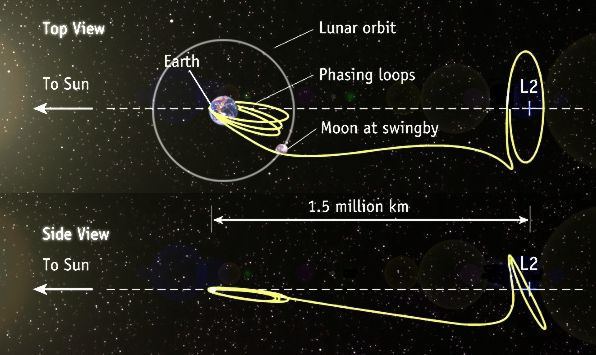 | ||
In orbital mechanics, a Lissajous orbit ([li.sa.ʒu]), named after Jules Antoine Lissajous, is a quasi-periodic orbital trajectory that an object can follow around a Lagrangian point of a three-body system without requiring any propulsion. Lyapunov orbits around a Lagrangian point are curved paths that lie entirely in the plane of the two primary bodies. In contrast, Lissajous orbits include components in this plane and perpendicular to it, and follow a Lissajous curve. Halo orbits also include components perpendicular to the plane, but they are periodic, while Lissajous orbits are not.
Contents
In practice, any orbits around Lagrangian points L1, L2, or L3 are dynamically unstable, meaning small departures from equilibrium grow over time. As a result, spacecraft in these Lagrangian point orbits must use their propulsion systems to perform orbital station-keeping. In the absence of other influences, orbits about Lagrangian points L4 and L5 are dynamically stable so long as the ratio of the masses of the two main objects is greater than about 25, meaning the natural dynamics (without the use of a spacecraft's propulsion system) keep the spacecraft in the vicinity of the Lagrangian point even when slightly perturbed from equilibrium. These orbits can however be destabilized by other heavy nearby objects. It has been found for example that the L4 and L5 points in the Earth–Moon system would be stable for billions of years, even with perturbations from the sun, but because of smaller perturbations by the planets, orbits around these points can only last a few million years.
Spacecraft using Lissajous orbits
Several missions have used Lissajous orbits: ACE at Sun–Earth L1, DSCOVR at Sun–Earth L1, WMAP at Sun–Earth L2, and also the Genesis mission collecting solar particles at L1. On 14 May 2009, the European Space Agency (ESA) launched into space the Herschel and Planck observatories, both of which use Lissajous orbits at Sun–Earth L2. ESA's current Gaia mission also uses a Lissajous orbit at Sun–Earth L2. In 2011, NASA transferred two of its THEMIS spacecraft from Earth orbit to Lunar orbit by way of Earth-Moon L1 and L2 Lissajous orbits. China's lunar orbiter Chang'e 2 left lunar orbit on June 8, 2011 and was placed in a Lissajous orbit at Earth-Sun L2 until mid-2012 prior to leaving Earth orbit entirely to fly by the asteroid Toutatis.
Fictional appearances
In the 2005 science fiction novel Sunstorm by Arthur C. Clarke and Stephen Baxter, a huge shield is constructed in space to protect the Earth from a deadly solar storm. The shield is described to have been in a Lissajous orbit at L1. In the story a group of wealthy and powerful people shelter opposite the shield at L2 so as to be protected from the solar storm by the shield, the Earth and the Moon.
